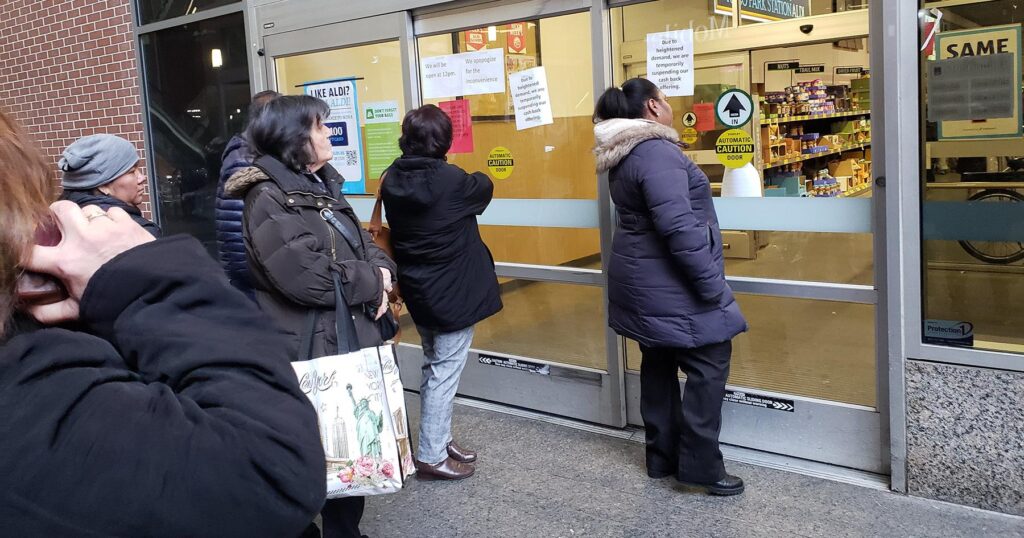John Springer
Winsight Grocery Business
John Springer
Winsight Grocery Business

As federal and local authorities ponder the challenge of “reopening” the country following weeks of coronavirus lockdowns, it won’t necessarily mean a return to “normal” conditions is anywhere close. Indeed, it seems likely that many of the compromises made to mitigate the coronavirus spread during the crisis will remain in place.
For grocery stores this could mean that capacity constraints and other store-traffic measures temporarily enacted—voluntarily or by local decree—could remain. This prospect alone is already having an impact on consumer behavior while challenging retailers to implement changes in everything from their assortments to labor and operations, sources say.
Ultimately this could also force them to rethink their physical spaces more intelligently, asking, for example, whether the emergency distancing guidelines they’ve been operating under for the past six weeks even make sense. In many cases, capacity limits have been determined by fire codes, which while safety-focused, have little to do with effective social distancing, sources note. Other emergency methods such as one-way aisles have anecdotally proven difficult to enforce.
“That’s where we’re trying to get into the conversation,” said George Shaw, founder of Pathr.ai, a technology built around “spacial intelligence” that helps retailers understand the movement of people in environments using artificial intelligence gleaned from store surveillance. “The fire codes are set for a very different reason, and they’re like sort of a really blunt instrument to figure out how many people you can allow.
“What retailers are doing now is saying, ‘Let’s take the fire code and cut it in half. That’s probably the right number of people now that everybody wants social distance.’ So you’ve taken this number that wasn’t designed to reflect social distance at all,” Shaw said in an interview. “It’s got a whole different purpose—making sure you have enough exits to get out of the places in a fire. And then arbitrarily cutting it in half and saying, ‘Well that’s probably the right number.’ ”
Although different retailers have set different thresholds for capacity during the crisis, most are based on some interpretation of their fire capacity. Walmart has said it would allow no more than five customers per 1,000 square feet, or about 20% of capacity. Kroger said it was halving capacity at about 1 shopper per 120 square feet. Some Costco stores are seeing capacity constrained to about 10% of capacity, a recent Barclays report noted.
To Shaw, none of these are necessarily the “right” number. “It’s either going to be too high, which means you’ll have too many people into the store and you’re not going to have adequate social distance, or too low, which means you’ve eliminated potential customers because you wouldn’t allow them through the door.”
Shaw argues that retailers that intelligently monitor and understand their traffic can be in better shape to address longer-term questions of capacity and flow that are certain to be a topic of “reopening” conversations and of store operations in the months ahead. “Let’s calculate that number intelligently,” he said. “How many people belong in your store? Let’s give you a better way to do that and that’s what we’re out doing now. Then the next thing I think will be let’s optimize that a little better.”
Kroger, for example, is using its QueVision technology, originally designed to address checkout efficiency but now to also monitor flow in the stores.
James McCann, the former Ahold USA CEO who now runs a private investment firm focused on consumer innovations, said capacity constraints would likely affect numerous areas of operations, noting that smaller stores would generally be more vulnerable as capacity constraints affect a greater percentage of their pre-COVID sales. Policing in-store traffic can also lead to additional labor costs, said McCann, who further predicted retailers would look into queuing systems to manage peak time periods—“think deli ordering tickets but electronically-enabled with customers awaiting in their cars rather than lining up outside the store”—and technologies such as mobile checkouts.
Consumers in the meantime will make less frequent but larger shopping trips—a phenomenon already experienced by retailers such as Target and Grocery Outlet—and hit online food shopping in greater numbers, he added. “The single biggest differentiator in the next 12 months will be retailer’s ability to serve the omnichannel customer,” McCann said.